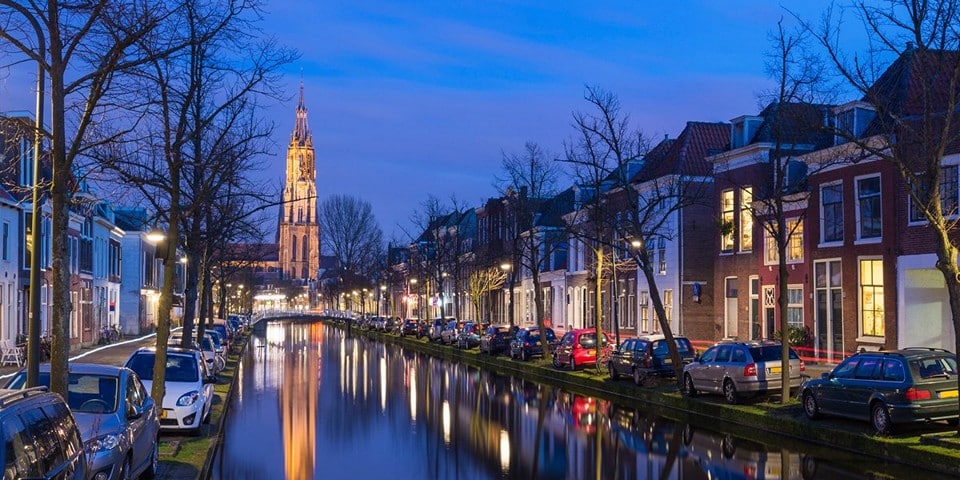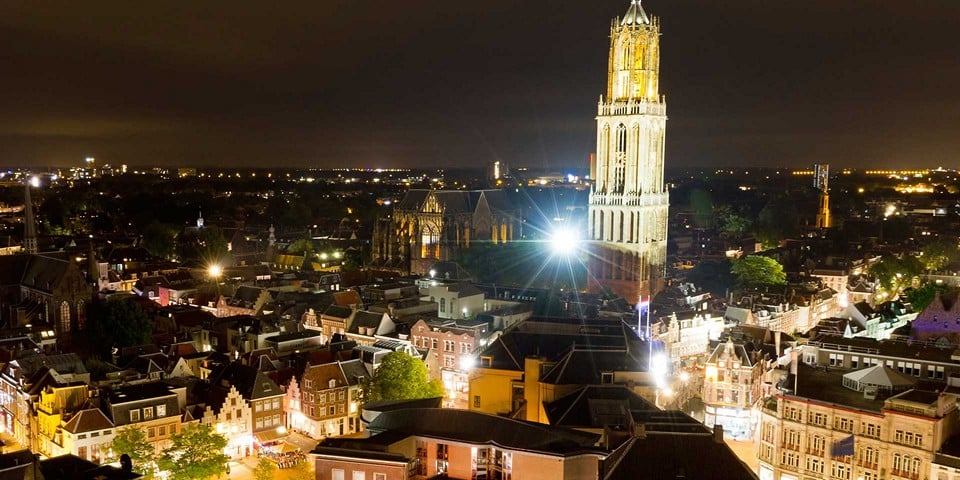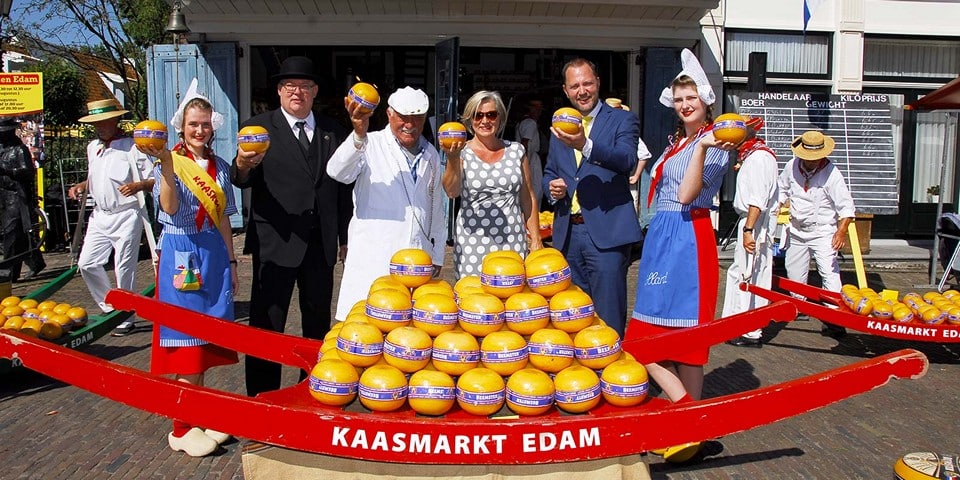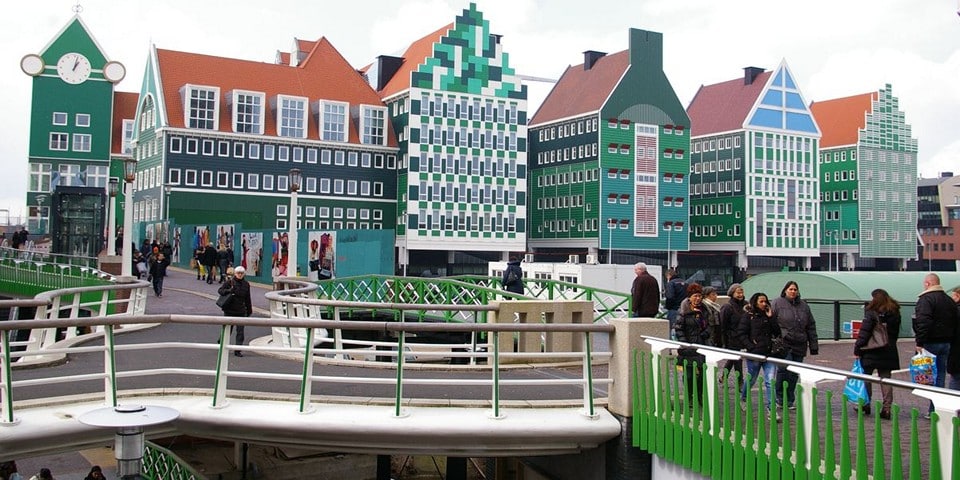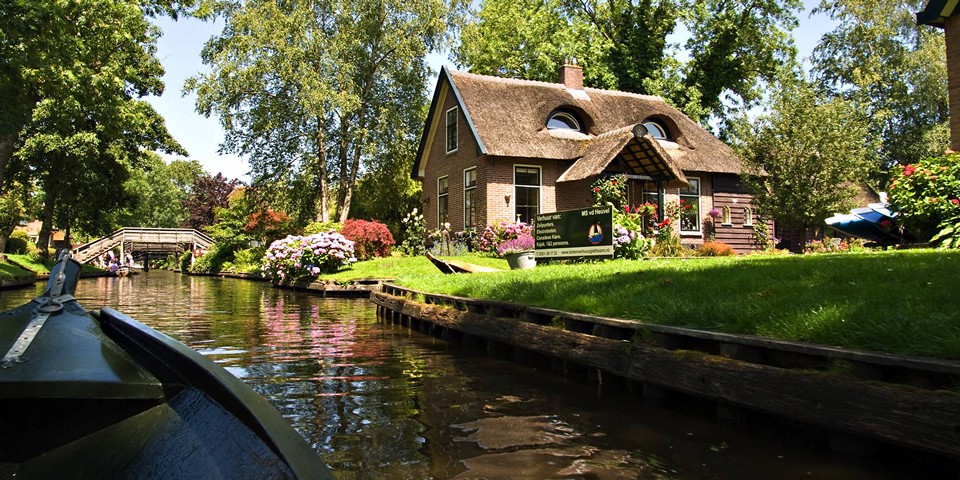Delft (Delft) is the first capital of the Netherlands: this city was chosen for his residence by William of Orange, who led the uprising against the Spaniards in the XVI century. When the prince was killed by the conspirators, he was buried in one of the local churches, Nieuwe Kerk. Since then, the deceased representatives of the Dutch royal family have been buried in this attraction.
Geography
Delft is located in the province of South Holland (Zuid-Holland), between two major Dutch cities - Rotterdam (Rotterdam) and The Hague (Den Haag). Delft is 16 km away from the first city, and 11.5 km from the second. If you look at the map, you can see that Amsterdam, the capital of the Netherlands, is located 68 km from Delft.
The area of Delft is 24.08 km2, with about 100 thousand inhabitants. Among them - 70 % Dutch, 25% - Indians, Turks, Surinamese, Moroccans, Chinese.
The Schie river flows through the city. In the southern part of Delft, it is called Delftse Schie, in the northern part it turns into Rijn-Schiekanaal. As in many cities in the Netherlands, many canals have been dug here, but only a few of them are used for navigation.
History
The history of Delft can be divided into two periods. The first is the emergence of a settlement, the provision of city rights to it and participation in the struggle for the independence of the Netherlands. The second is modern history, when Delft from a developed trading city turned into the main center for the creation of high technologies in the country.
Early history
The name Delft was given to the settlement that stretched around a canal dug in this area in 1100. The village was named “delf”, which means “artificially dug canal”. Due to its favorable location, the settlement initially became an important trade center. Its population increased rapidly, thanks to which Delft received city rights in 1246. In the middle of the XIV century. Delft was surrounded by medieval walls, beyond which it did not go until the 19th century.
In 1536, a fire broke out in the city, during which all the wooden buildings burned down. It took local residents about a century to restore the city. This is largely due to the fact that in the 60s. XVI century the Dutch rebelled against Spanish rule - and in 1572 Delft joined the rebels.
At the head of the resistance was Prince William of Orange, who wanted to unite not only the northern, but also the southern provinces of the country. Therefore, he did not immediately accept the Utrecht Union, which the northern regions concluded among themselves, forming an independent state - the Republic of the United Provinces (Republiek der Zeven Verenigde Nederlanden). But when the prince realized that unification was impossible, he led the allied forces.
William of Orange was assassinated more than once, and one of the attempts was successful. While the prince was in his residence, he was killed by the Catholic fan Balthazar Gerard, firing several bullets at point-blank range. Wilhelm died almost instantly, and his killer was caught and sentenced to a cruel death: they cut off his right hand with a hot iron, removed the skin, quartered, tore out his heart and cut off his head.
Modern history
In the XVII century. The Dutch East India Company opened an office in Delft, which contributed to the prosperity of the city: coffee, tea, aromatic spices, Chinese porcelain arrived here from overseas, and trade was brisk. At the same time, workshops for the production of white and blue porcelain appeared in the city, whose products became famous all over the world.
In the middle of the 17th century. a tragedy happened: a gunpowder warehouse located in the city center exploded, which stored 45 tons of gunpowder, which led to severe destruction and numerous casualties. When the city was rebuilt, the authorities became smarter, and therefore the arsenal was equipped on the outskirts.
In 1672, Delft ceased to be a major trading city as trade moved to The Hague and Rotterdam. Instead, it acquired an industrial character: in 1842, the Royal Academy for the Training of Engineers was opened here, which is known as the Technische Universiteit Delft. It is the oldest and largest technical educational institution in the country, among whose alumni there were Nobel Prize winners in physics and chemistry.
A yeast and distillery factory (Koninklijke Nederlandsche Gist- en Spiritusfabriek) also appeared in the city; for the first time in the country, a working quarter, Agnetapark, was built.
Attractions
Delft resembles a toy town - old low-rise buildings, numerous canals, lack of crowds. Although numerous corporations are concentrated here, whose employees are working on the development of the latest technologies, outwardly Delft looks like an untouched by the rapid development of civilization, a provincial city frozen in time.
Town hall
The Delft Town Hall (Stadhuis van Delft) is one of the most beautiful sights in the city. The first building of the mayor's office was built by the townspeople in 1200. It was a powerful stone structure with a tower, inside which there was a prison, where at one time the murderer of William of Orange, Balthazar Gerard, awaited a verdict.
The City Hall managed to withstand the fire in 1536, but a fire in 1618 destroyed it, leaving only a prison. Hendrick de Keyser was assigned to develop the new project. He left the tower and built a two-story Renaissance-style building near it. The mayor's office was restored in record time: two years after the fire, the construction was completed, and The tower that became part of the town hall is currently the oldest building in the city.
Now the city council meets in the mayor's office, weddings are held. In memory of the past, a torture museum was opened here. To visit it, you need to make an appointment with the tour desk in advance. The entrance to the town hall is usually closed for tourists, but excursions are sometimes held during the summer months. Also, various events are periodically arranged inside the city hall, and you can get into the building after buying a ticket.
- Address: Markt, 87 (Market Square);
- Web site: delft.nl;
- Information about the torture museum: www.delft.nl.
Old church
Most drThe oldest temple in Delft is the Oude Kerk Delft, which is translated as “The Old Church”. The Oudekerk was built in 1246 between two canals. A hundred years later, a 75-meter bell tower appeared near the church, for the construction of which, due to lack of space, one of the canals was partially filled up. Thus, half of the tower was built on sandy ground, half on the ground, which was covered with a reservoir. The bell tower turned out to be too heavy for such soil, so the building began to tilt. Now the angle of inclination of the bell tower is deviated from the axis by two meters, which is why the building resembles the Leaning Tower of Pisa, and the locals call it the Falling Jan (Scheve Jan).
The strong inclination of the bell tower has worried the inhabitants of the city for centuries. In 1843, the city council decided to reduce the structure to the level of the roof of the main nave of the church. Residents opposed this decision, and a more expensive project was chosen to strengthen the tower, as a result of which the fall of the bell tower stopped. But tourists don't come here.
In 1570, the largest Bourdon bell in the Netherlands appeared on the bell tower (Bourdon), whose weight is about 9 tons, diameter - 2.3 m. Since during the ringing it creates extremely strong vibrations that can damage the tower, the bell sounds only during the funeral of members of the royal family.
In Oudekerk, services are still held on Sundays and Christian holidays, which anyone can attend for free. Those wishing to see the church at another time will have to pay for the entrance. Organ music concerts are also given at the temple.
- Address: Heilige Geestkerkhof, 2, 25;
- Web site: oudeennieuwekerkdelft.nl;
- The Old and New Churches have one site, they work at the same time. Therefore, when visiting them, it is better to buy a combined ticket, which allows you to see the Oudekerk, Newkerk and the tower with it. The museum card is not valid here. The temples are located at a distance of 500 m from each other (5 min. Walk).
New church
Nieuwe Kerk or New Church is located on Market Square opposite the City Hall. William of Orange and other members of the royal family are buried here. The New Church is also known for its bell tower, which is 108.75 m high, which makes it the second tallest in the Netherlands.
The first wooden church dedicated to the Virgin Mary appeared in 1351. Since the church turned out to be the second Christian church built in Delft, it was named so - Nieuwe Kerk. Eighteen years later, it was decided to replace the wooden building with a stone one, and in 1420 the construction was completed. The bell tower was erected longer, completing the work only by 1496. A new landmark was dedicated to St. Ursula.
The bell tower turned out to be fatal for the city: in 1535 lightning hit it, causing not only the destruction of the church, but also a terrible city fire. A hundred years later, the temple suffered greatly from the explosion of the powder store, but a year later the church was restored. In 1872 p. lightning destroyed the spire of the bell tower.
The reconstruction of the temple was carried out more than once, its stained-glass windows are especially noteworthy. Also installed here is an organ that has 3 thousand pipes and 48 votes. The bells appeared on the belfry in 1660. The New Church is an active church. Organ concerts are also regularly held here.
- Markt, 80;
- Web site: oudeennieuwekerkdelft.nl;
- Opening hours: November-January from 11 to 16 (Saturday from 10 to 17), February and March from 10 to 17, April-October from 9 to 18. The tower closes an hour earlier than the church;
- Combined ticket (Old and New churches + tower): adults - 8 €, children from 12 to 18 years old, as well as students - 5.5 €, children from 6 to 11 years old - 2.5 €, younger - only entrance the church is free of charge, the tower is not allowed.
Prinsenhof
The Prinsenhof Palace (Prinsenhof), which means "Prince's Court", got its name due to the fact that the residence of William of Orange was located here. Now it houses the Museum Prinsenhof Delft art museum, where you can see the canvases of local painters of the 16th-17th centuries, the famous Delft porcelain, silver products, objects of modern art.
Before becoming a residence, from 1403 there was a convent of St. Agatha (Sint-Agathaklooster), which during the Reformation in the second half of the XVI century. passed into the possession of the Prince of Orange. At the same time, the nuns were not dispersed, but a small space was allocated for them to live. In addition, a Protestant chapel was installed in the building.
Wilhelm adapted most of the monastery for his needs: here he lived and worked. In the same building, Balthazar Gerard killed him, and on the wall of the stairs that led to the prince's rooms, traces of bullets are still preserved. Nearby is a death mask.
- Address: Sint Agathaplein, 1, near the Old Church;
- Web site: prinsenhof-delft.nl;
- Opening hours: from 11 to 17;
- Ticket price: adults - 12 €, from 13 to 18 years old - 6 €, from 4 to 12 years old - 3 €, younger people are free.
How to get
Amsterdam is 68 km from Delft, so the journey here will take about an hour. To do this, you can use the train and car. It is inconvenient to travel by bus, because you need to get there with transfers.
By train
Trains leave from Station Amsterdam-Zuid and Amsterdam Centraal every 20 minutes. during the day and once an hour at night. Arrives in Delft after 45-60 minutes, some routes go through Schiphol Airport. For a ticket in the second class you have to pay 13 €, in the first class - 22.1 €. More details about the schedule, routes and prices can be found on the website www.ns.nl.
By car
A car ride from Amsterdam to Delft takes an hour. To do this, take the A10 motorway (Amsterdam-West) and follow it to the A4 / E19 motorway, then head towards Oostpoortweg (Delft). On reaching the A13 / E19 motorway, take exit 9-Delft towards Delft. Then continue along Oostpoortweg, Julianalaan, Mijnbouwstraat, Zuidwal, Lange Geer and Koornmarkt towards Oude Langendijk.
Why come here
The sights of Delft are definitely worth seeing for anyone interested in the history of the royal family, and also wants to wander in peace and quiet along the narrow medieval streets. The eastern gate from the medieval walls (Oostpoort), palaces and castles have been preserved here. You can also visit the Royal Delft - Koninklijke Porceleyne Fles on Rotterdamseweg, 196. Here you can not only watch the craftsmen at work, but even try to mold, burn, decorate something yourself.
And in the old cemetery near the Royal Yeast and Distillery is the grave of the Berlin watchmaker la Karl-Wilhelm Naundorf, who posed as King Louis XVII of France, claiming that the monarch died and managed to escape the Temple prison. Naundorf is the only contender whose words have not yet been refuted, and whose descendants received the right to the Bourbon surname.
